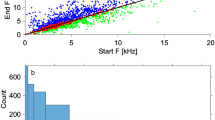Summary
Vocalizations of free-ranging North Atlantic pilot whales were studied in different behavioral contexts to gain insight into the function and biological significance of different sound types. Simple whistles (with no frequency inflections) were heard more frequently when whales were “milling,” a restful behavior type. During “surface active” behavior, energetic, often coordinated activity probably representing feeding, many sound types, especially complex whistles (with more frequency inflections) and pulsed sounds, occurred with greater frequency than when this behavior was absent. Greater numbers of most whistle types were produced when whales were spread over a larger area and when more subgroups were present. Thus, in pilot whales, there is a significant relationship between their sounds and their behavior, with vocalizations possibly serving to maintain contact and coordinate movements of the herd.
Similar content being viewed by others
References
Caldwell MC, Caldwell DK (1965) Individualized whistle contours in bottlenosed dolphins (Tursiops truncatus). Nature 207:434–435
Caldwell DK, Caldwell MC (1977) Cetaceans. In: Sebeok TA (ed) How animals communicate. Indiana University, Bloomington, pp 794–808
Clark CW (1983) Acoustic communication and behavior of the southern right whale (Eubalaena australis). In: Payne R (ed) Communication and behavior of whales. Westview, Boulder, CO, pp 163–198
Dreher JJ (1966) Cetacean communication: a small group experiment. In: Norris KS (ed) Whales, dolphins, and porpoises. University of California, Berkeley, pp 529–541
Herman LM, Tavolga WN (1980) The communication systems of cetaceans. In: Herman LM (ed) Cetacean behavior. Wiley, New York, pp 149–210
Kellogg WN, Kohler R, Morris HN (1953) Porpoise sounds as sonar signals. Science 117:239–243
McLeod PJ (1982) Vocalizations of the pilot whale (Globicephala melaena Traill). MSc thesis, Memorial University of Newfoundland
Norris KS (1969) The echolocation of marine mammals. In: Andersen HT (ed) The biology of marine mammals. Academic Press, New York, pp 391–423
Norris KS, Dohl TP (1980) Behavior of the Hawaiian spinner dolphin, Stenella longirostris. Fish Bull 77:821–849
Norris KS, Prescott JH, Asa-Dorian PV, Perkins P (1961) An experimental demonstration of echolocation behavior in the porpoise, Tursiops truncatus (Montagu). Biol Bull 120:163–176
Partan S, Jerger K, Xitco M, Roitblat H, Herman L, Williams H, Hoffhines M, Gory J, Ralston J (1988) Behavior specific vocalizations of two Atlantic bottlenose dolphins (Tursiops truncatus). (Abstract). J Acoust Soc Am (Suppl 1) 84:S77
Saayman GS, Taylor CK, Bower D (1973) Diurnal activity cycles in captive and free-ranging Indian Ocean bottlenose dolphins Tursiops aduncus Ehrenburg. Behaviour 44:212–233
Sebeok TA (1977) How animals communicate. Indiana University, Bloomington
Silber G (1986) The relationship of social vocalizations to surface behavior and aggression in the Hawaiian humpback whale (Megaptera novaeangliae). Can J Zool 64:2075–2080
Taruski AG (1976) Sounds and behavior of the pilot whale. PhD thesis, University of Rhode Island
Taruski AG (1979) The whistle repertoire of the North Atlantic pilot whale (Globicephala melaena) and its relationship to behavior and environment. In: Winn HE, Olla BL (eds) Behavior of marine animals, vol 3. Plenum Press, New York, pp 345–368
Tyack P (1981) Interactions between singing Hawaiian humpback whales and conspecifics nearby. Behav Ecol Sociobiol 8:105–116
Weilgart LS (1985) Vocalizations of the North Atlantic pilot whale (Globicephala melaena Traill) as related to behavioral and environmental contexts. MSc thesis, Memorial University of Newfoundland
Author information
Authors and Affiliations
Additional information
Offprint requests to: L.S. Weilgart at the current address
Rights and permissions
About this article
Cite this article
Weilgart, L.S., Whitehead, H. Vocalizations of the North Atlantic pilot whale (Globicephala melas) as related to behavioral contexts. Behav Ecol Sociobiol 26, 399–402 (1990). https://doi.org/10.1007/BF00170896
Received:
Accepted:
Issue Date:
DOI: https://doi.org/10.1007/BF00170896




